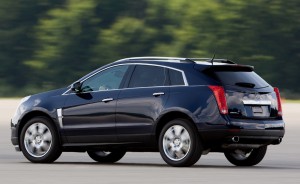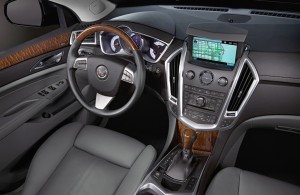
How it rated
(1-5 dots, 5 being best)
performance •••
interior ••••
handling ••••
styling •••••
overall ••••
Good: Excellent ride and handling, mostly well-done interior
Bad: Optional turbo engine needs more oomph, premium fuel required
Bottom line: Watch out Lexus RX, Cadillac’s new nipped and tucked SRX crossover is in your rearview mirror
• Base price: $34,125
• Price as tested: $53,980
• Powertrain: six-speed automatic transmission, all-wheel drive
• Engine: 2.8-liter turbocharged V-6 with direct injection
• Horsepower: 300
• Curb weight: 4,508 pounds
• MPG: 15 city, 22 highway
• Built: Arizpe, Mexico
Consider the first-generation Cadillac SRX. While many in the motoring press gave it fantastic reviews, buyers were left cold.
General Motors thinks it knows why. The first-generation vehicle was too low, too long. In other words, it was a station wagon and Americans’ dislike for station wagons is well known.
For the second generation SRX, GM corrected those issues. The new vehicle is shorter in length, but taller. The third row is jettisoned in the process. Of course, the SRX is dressed in the latest iteration of GM’s knife-edge Art and Science design style. One really cool detail: A character line that starts on the side of the front bumper is continued through the doors after it skips the front wheel well.
Many more changes accompany the new crossover. Gone is the rear-wheel drive platform, replaced with front-wheel drive. All-wheel drive, as before, is an option. A pair of new engines replace horsepower 3.6-liter V-6 and the 4.6-liter Northstar V-8.Base SRXs come with a direct injection 3.0-liter V-6 developing 265 horsepower. The new optional powerplant is a sequential injection 2.8-liter turbo making 300 horsepower. Both engines are mated to six-speed automatic transmissions, a GM unit for the standard engine and an Aisin box for the turbo. The turbo engine comes only with all-wheel drive.
The SRX offers a stellar driving experience. The ride is very good, it tracks like a champ and is delightful on curving roads. The only beef is that the optional engine could use a bit more power. Those who opt for the nonturbo engine probably won’t mind the power deficit, but those seeking more performance will want more than what the optional engine offers.
The turbo comes with a mileage penalty for those extra 35 horses as well. The turbo AWD is rated at 15 city and 22 highway, while a nonturbo AWD version is rated at 17/23. The nonhybrid Lexus RX350, sold only with a 275-horsepower 3.5-liter V-6, is rated at 18/24 for the AWD model.
Inside, the SRX is reminiscent of the CTS, Cadillac’s most popular vehicle. The interior is beautifully done with many elements that show the designers’ attention to detail. Just one thing marrs an otherwise great interior: The door on a small compartment in front of the shifter is difficult to open and feels spongy.
But there’s a lot to like elsewhere. The seats are comfortable, much better than a recently tested CTS and the dash has a cool look with an information screen in the middle of the speedometer. Navigation-equipped models can show a speed limit sign in this display for major streets.
The back seat is comfortable, although kneeroom could be better. Headroom is acceptable, even with the Ultraview dual-panel sunroof.
One demerit is the driver’s door on the test vehicle was not aligned properly with the body.
The test vehicle did not have a spare tire. In it’s place was can of sealant and an inflator, along with a nicely finished storage area below the rear floor. The rear seats fold down 60/40, but there’s also a pass through for longer items such as snow skis.
The SRX has a base price of $34,125 with front-wheel drive and the 3.0-liter V-6. Standard features include and an 8-speaker Bose sound system, push button start and dual zone automatic climate control. This test vehicle, a 2.8L Turbo Premium AWD starts at $52,685 and stickers at $53,980, with one option, a rear seat entertainment system with dual screens ($1,295).
It’s surprising that Cadillac does not yet offer a blind-spot alert system or adaptive cruise controls, both of which are becoming more common options on luxury vehicles.
Even though the outgoing model was well-liked by scribes, the buying public voted with their checkbook for the Lexus RX instead. Cadillac has now cribbed from Lexus’ playbook with a new SRX that looks like a crossover rather than a station wagon. Let the sales battle begin.


